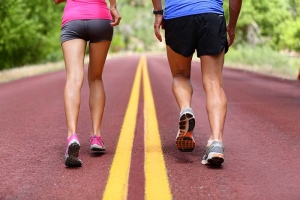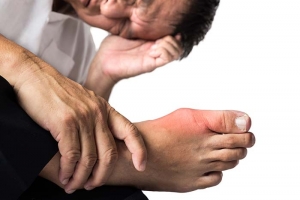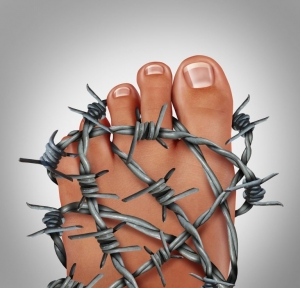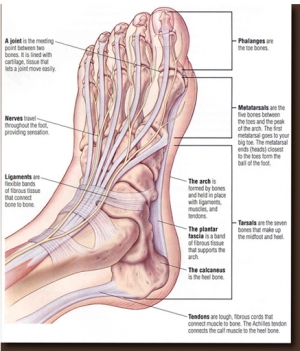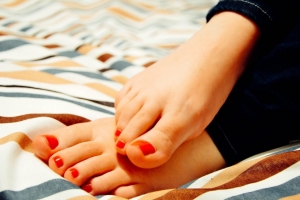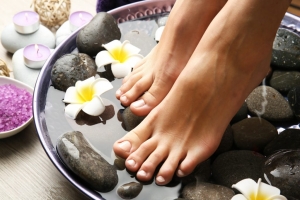Connect With Us
Blogs
Running on Pavement
Running on Pavement: How Bad Is It For Your Feet?
Any avid runner has weighed in on the debate: which surface is best for running? The science aside, you probably have a personal preference, or are even limited by your immediate surroundings. For many of us, convenience is the deciding factor—and that means running on the ubiquitous pavement of city and suburbia.
While running on pavement poses its unique dangers, you can avoid injury with the right steps and the care of a trusted podiatrist.
The Impact of Running on Pavement
The mechanics of running are complex, with the incidence of injury the result of various factors other than the hardness of the surface you run on. While the jury is still out on whether running on hard surfaces is definitively bad for your feet, it does pose its unique dangers. The two main factors behind the arguments against running on pavement are the negative effects associated with impact and repetition.
Impact: Running is one of the roughest activities our feet can endure. The feet bear up to two to four times your normal body weight while running, repeated up to thousands of times over the duration of your trek. The feet play an integral part in the two essential steps of running: landing and push-off. When running on a hard surface like concrete or asphalt, the ground does not absorb any of the shock of impact upon landing. The weight of impact is then borne fully by the feet, sending vibrations up the leg when landing. When repeated continuously, this process can result in increased injury to the legs and feet.
While running on any pavement is not considered ideal, keep in mind that concrete is considered far worse than asphalt.
Repetition: Citing the aforementioned effects of impact on the feet, repetitive impact causes constant stress to the same muscles and bones in the body, leading to specific injuries. While asphalt would appear to be easier on the body due to its continuous nature, the continuity actually forces the body to endure repetitive trauma to certain muscles. The body is designed to adapt to its surroundings, not bear monotonous stress. Training across various terrains will even out the impact endured while running, lessening the likelihood of injury from repeated trauma.
However, this does not necessarily make running on grass or soil the superior alternative. Softer surfaces like nature trails tend to be more irregular, which is their dual benefit and risk. On one hand, you avoid repetitive impact and injury to the same muscles and bones, which you would suffer on a continuous surface like asphalt. On the other hand, uneven surfaces could present unforeseen obstacles such as pits and dips, resulting in sprains or even broken bones. The best recommendation is to switch up the terrain, to avoid constant impact and injury to certain parts of the body.
Training Tips for City Runners
Regardless of what surface you run on, running injuries are more a function of poor preparation than surface rigidity. A serious runner will know what to expect, and take preventative measures to avoid injury by becoming properly equipped. The first step in this is gaining intimate knowledge of your foot’s unique physiology and its needs, and that starts with consulting a certified podiatrist. Only a trained podiatrist can understand the support demanded by your unique foot anatomy and running patterns, and will advise you on what orthotics and shoes you require to avoid undue foot trauma. Common foot injuries suffered by runners include: plantar fasciitis, heel spurs, stress fractures, and Achilles tendonitis.
Before starting any running regimen, follow these steps:
- Consult your podiatrist. No two feet are the same – not even your feet. Only your podiatrist can identify physical conditions such as fallen arches, or recognize irregularities in your movement patterns such as overpronation. Both require special medical attention to avoid injury when running. In addition to this, no two feet are completely identical, with one possibly requiring extra attention. Consult your podiatrist to determine if you require custom orthotics, supportive inserts, or a specific type of shoe to reduce trauma when running.
- Wear the right shoes. The right equipment is essential to peak performance, and this is especially the case with running. Depending on your running form, you will likely require maximum cushioning and support to reduce the shock of impact, and a flexible sole designed to allow full range of motion. Further specialization is required if your feet overpronate, or if you have wide or narrow feet. Be sure to get shoes designed for the terrain you typically train on, whether it be nature trails or city streets. While running shoes can be extremely expensive, consider it an investment in your foot health.
- Change the terrain. Again, repetitive impact to the same muscle groups can lead to injury. Switching between softer and harder surfaces will allow your body to adapt to different conditions, and provide more comprehensive training to all muscle groups.
Schedule a Consultation with Dr. Vikki and Dr. Connie
To keep your feet in prime shape, schedule a consultation with esteemed podiatrists Dr. Vikki and Dr. Connie today. For all of your podiatric needs, contact the caring specialists at the Superior Foot & Ankle Care Center.
Athlete’s Foot
What is Athlete’s Foot?
Athlete’s foot is a fungal infection caused by the tinea fungus, and is usually found between the toes. Its medical name is tinea pedis– ringworm of the feet. It most commonly affects those who are highly active, and thus prone to having sweaty feet confined within tight shoes often and for extended periods of time.
Athlete’s foot is not only embarrassing, but highly contagious. The infection can spread via contaminated surfaces such as floors and laundry. If not careful, the infection can also spread to other parts of the body, such as the hands, nails, and groin.
Learn more about the symptoms of athlete’s foot, and how to prevent an infection of your own.
Athlete’s Foot Symptoms
The visual indication of an athlete’s foot infection is a red rash between the toes that is scaly in appearance, with some occurrences even presenting blisters or ulcers. This rash causes the sensations of itching, stinging, and burning. The itching is usually most intense immediately after removing the socks and shoes.
You may also experience dry, cracked, raw, or peeling skin between the toes and on the soles of the feet. Thick, discolored toenails detached from the nail bed are another indication of an infection.
Some strains of the tinea pedis fungus can cause chronic dryness and chafing on the soles and sides of the feet. This can often be mistaken for other skin conditions such as eczema. The infection can spread to other parts of the body, such as your hands, if you pick at the infected sites.
Causes & Risk Factors
Athlete’s foot is closely related to ringworm and jock itch, and is actually caused by the same fungal infection. The tinea pedis fungus thrives in warm, damp environments, making sweaty socks the perfect incubator for its growth. It is most commonly found in moist public spaces, such as communal locker rooms, public showers, gyms, and swimming pools. Walking anywhere barefoot is highly discouraged.
Certain environmental factors put you at higher risk of contracting an athlete’s foot infection. For one, males are more likely to develop the infection. If you are highly active, meaning that you wear sweaty socks for extended periods of time, then you are at higher risk. Since the fungus is highly contagious, being exposed to an environment such as a communal gym or shower with an infected individual makes you extremely likely to catch the infection. Moreover, if you share a home with someone who is infected, you may catch the infection through contaminated floors, shared bedding, shared towels, etc. For this reason, those who tend to walk barefoot in public spaces are at a higher risk. This includes those with compromised immune systems, such as those with diabetes.
Athlete’s Foot Diagnosis
An experienced podiatrist can often diagnose an athlete’s foot infection through visual confirmation. However, he or she may also take skin samples to view under a microscope or send to a lab for testing for a definitive diagnosis.
Common tests include:
- PAS stain
- Skin culture
- Skin biopsy
Athlete’s Foot Treatment
Athlete’s foot is similar to other common fungal infections, and mild cases can be treated with over-the-counter antifungal medications such as creams and ointments. Over-the-counter antifungal medications include: Lamisil AT and Lotrimin AF.More serious cases may require prescription medication to be applied topically to the feet. For the most severe cases, your doctor may prescribe oral antifungal pills to flush out the infection. Common oral antifungal prescriptions include: Sporanox, Diflucan, Gris-Peg or Lamisil.
At home, you may soak your feet in salt water to help remedy the blistering. Tea tree oil is also a common natural remedy used with some limited success. Of course, only a doctor’s visit can be trusted to completely eliminate the infection.
Prevention
The most effective treatment for any infection is prevention.
- Avoid walking barefoot in any public space, especially ones that are humid and moist such as a locker room.
- If you know that a family member has contracted the infection, do not walk barefoot on any communal floors, and refrain from sharing linens such as bedding and towels. Even try to use different showers until the infection clears, if possible.
- Wash your feet thoroughly with antibacterial soap, and dry them fully.
- Apply antifungal powders daily, if necessary.
- Wear socks with breathable fibers such as cotton or wool, or specially designed moisture-wicking features.
- Change your socks as often as possible, and alternate between different pairs of shoes to allow them to dry out between uses.
- If the infection seems unavoidable due to a highly active lifestyle, seek treatment at the first signs of infection to avoid it from spreading to the hands, nails, or groin.
- Seek medical attention immediately if you have diabetes or compromised immune health.
Potential Complications
The fungal infection can potentially spread to your hand, your nails, and your groin (jock itch).
You may also develop an allergic reaction to the fungus, resulting in blistering on the affected area. Moreover, an additional bacterial infection may develop. A bacterial infection may also be present if your foot becomes painful and swollen, or if it develops pus and drainage. Seek medical attention if you develop a fever to prevent the infection from spreading throughout the body.
Consult Esteemed Podiatrist Dr. Vikki
If you suspect that you may have an athlete’s foot infection, schedule a consultation with podiatrist Dr. Vikki today. Dr. Vikki is a diplomat of the Board of Podiatric Surgery, and the trusted podiatrist of the Special Olympics. Just look to her well-earned reputation for excellence in patient care. For all of your podiatric questions and concerns, contact the specialists at the Superior Foot & Ankle Care Center.
What is Cellulitis
Understanding Cellulitis
Cellulitis is a very common form of bacterial infection which can cause redness, swelling, and a warm sensation under the skin. It appears on the lower legs, although it can also appear on other areas of the body and face as well.
If left untreated, Cellulitis can quickly turn from an infection to an abscess, or even a much more serious illness called Necrotizing-Fasciitis, or Flesh Eating Disease.
In 2013, roughly 37 million cases of Cellulitis were reported worldwide, with an estimated 30,000 deaths resulting from complications related to this infection.
Causes of Cellulitis
Cellulitis usually occurs when streptococcus or staphylococcus bacteria enter the body through an abrasion or cut. Those at particular risk are the elderly and those with pre-existing immune-deficiency conditions such as diabetes.
Owing to the decreased blood flow inherent with diabetes and other immune deficiencies, the bacteria, upon entering the body, are able to reproduce much quicker, making the condition much more aggressive.
However, it’s not just diabetes and immune-deficiencies which can lead to Cellulitis. There are many pre-existing conditions which can lead to cellulitis. Some common conditions are spider bites, eczema, Athlete’s Foot and open wounds from tattoos.
Others are more specific to children and the elderly.
Chicken Pox, for example, can leave a child’s skin open to infection. Similarly, bed sores and other abrasions common to the elderly can also lead to infection. Proper cleaning and sterilization of affected areas is always encouraged.
Densely-populated living spaces such as dormitories, hostels, retirement homes and shelters are common breeding grounds for Cellulitis. As with Athlete’s Foot and other highly contagious conditions, it can easily be transmitted through shared contact with hygienic facilities. Preventative measures like shower shoes and proper toweling-off are always recommended.
As this is an infection, it can spread quite easily through the bloodstream and into the lymphatic systems. It is extremely important that Cellulitis be treated early to avoid much more serious infections. Symptoms of infection include fever, chills, nausea and fatigue. Increased redness and swelling around the infected area are also common.
A diagnosis of Cellulitis can easily be made by a qualified health professional, like Dr. Vikki and the team at Superior Foot & Ankle Care Center. Obtaining a proper and timely diagnosis is crucial. The longer it is left untreated, the more likely it will develop into something much harder to treat.
Treatment for Cellulitis
Antibiotics are the most common approach to Cellulitis. Similar to other streptococci-caused illnesses like Strep Throat, It tends to clear up within the first week of antibiotic usage. However, for those on antibiotics who do not see improvement, additional measures may be required.
In some cases, Cellulitis will lead to an abscess. Abscesses are large, swollen areas with dark centers, which generally require surgery to drain. Any at-home attempts at drainage can lead to further complications.
Pain relief medication is often prescribed along with antibiotics. However, if the pain is extreme, medical help should be sought out as soon as possible as this may be a sign of developing Necrotizing-Fasciitis—a very aggressive infection which can lead to permanent disfigurement or death.
The preventative measures favored by Dr. Vikki and the team at Superior Foot & Ankle Care Center can help to prevent Cellulitis, and to cure any offshoot conditions.
As an active participant in the well-being of Special Olympians since 2003, Dr. Vikki understands the value of a proper diet and exercise in the prevention and treatment of Cellulitis. Excess blood sugars, like the kind that result from an improper diet can lead to increased bacterial spreading, which can exacerbate any stages of the condition.
Consult Superior Foot & Ankle Care Center
Along with a sound assessment, the staff at Superior Foot and Ankle Care can provide the educational tools necessary to prevent and treat Cellulitis.
Whether you have questions about an existing condition, or you’d simply like to learn more about how you can prevent this infection and other related health issues, schedule a consultation today with the professional team at Superior Foot and Ankle Care Center and start living healthier.
Morton’s Neuroma | What you can do
What Is Morton’s Neuroma?
Unlike most neuromas, Morton’s Neuroma is not a tumor. It is a benign build-up of tissue surrounding a nerve, which can cause pain and discomfort. Many people describe it as the sensation of having a rock in their shoe, while others describe it as a painful burning or numbing sensation upon bearing weight.
The sensations are most often triggered on the ball of the foot between the third and fourth toes. Even the smallest amount of weight pressing down on the foot can cause discomfort.
On a microscopic level, deterioration of the affected nerve can be detected, though there are usually no abnormalities visible to the naked eye. Dr. Vikki and her team at the Superior Foot & Ankle Care Center can not only provide a sound diagnosis, they can provide the level of care required to dramatically increase patient comfort and mobility.
Causes of Morton’s Neuroma
Morton’s Neuroma is often linked to wearing high heels, as well as to various forms of exercise. Women and runners are most likely to suffer from it due to the confining nature of high heels and running shoes. Existing issues such as hammertoes or bunions can also cause or exacerbate the condition.
Symptoms tend to appear slowly, beginning most often with pain upon wearing restrictive footwear. Removing the constrictive footwear should alleviate the symptoms temporarily, especially in conjunction with mild massaging, but overtime the symptoms will worsen, lasting for up to several weeks.
As the condition continues to develop, the damaging effects of the neuroma will become less and less reversible. Early action is the best defense against permanent pain and discomfort. The earlier the diagnosis, the more likely that more invasive treatment such as surgery can be avoided.
Treatment for Morton’s Neuroma
Many conditions can present similar symptoms to those of Morton’s Neuroma. Only a professional, highly skilled team like the professionals at Superior Foot & Ankle Care Center can identify the source of the problem and provide the proper treatment.
The most common treatments are corticosteroid injections and orthotics, but various other forms of treatment exist including radio frequency ablation and Sclerosing alcohol injections.
While non-invasive methods of treatment are more common, in some cases, surgery is required. A neurectomy is performed where the affected tissue is removed. In recent years, ultrasounds have become instrumental in diagnosing Morton’s Neuroma, and in assisting with treatments.
There are no effective at-home cures for Morton’s Neuroma. But there are a few things you can do to help alleviate some of the symptoms:
- Insoles are a good place to start. Custom-fitted insoles can help to alleviate the symptoms by taking weight off of the affected areas. They are only effective on symptoms, but they can provide quick relief.
- Applying an ice pack to the affected area can cut down on the swelling and provide a soothing sensation when the pain is most acute.
- A proper diet is key when dealing with issues like Morton’s Neuroma. As neuromas are triggered by weight distribution, lessening the amount of weight your feet have to bear is always a good place to start.
- Cutting back on physical activity can help to slow the progression of the condition.
- Purchasing more supportive footwear with wider toe boxes and lower heals can help to remove pressure from the balls of the feet.
- Finally, basic over-the-counter anti-inflammatory medications such as Ibuprofen can help to alleviate the pain.
While these methods can help to alleviate the symptoms, however, they cannot attack the actual issue, which is the thickening around the nerve tissue.
Contact Dr. Vikki Today
With the resources of a renowned podiatry clinic, as well as the preventative measures favored by the staff at the Superior Foot & Ankle Care Center you can find both relief and the tools necessary to prevent future issues. Don’t waste another day in pain.
Schedule an appointment today to talk to the well-renowned team at Superior Foot & Ankle Care center, and get back on your feet.
Protect Your Feet While Playing Sports
How To Protect Your Feet While Playing Sports
Anyone who has played sports knows just how strenuous it can be on your feet. Think of all the skilled movements you make as an athlete: the swift twists and turns in basketball, the rigorous sprints taken in a football or baseball game, and the hard landings made after a volleyball spike. Regardless of how fit you are, the physical demands of your sport will still leave you stepping off the court or field with sore, tired feet.
Considering the wear and impact a sport can take on your feet, there is always the likelihood of damage or injury. In order to keep yourself in top condition to compete, proper foot care is essential.
Proper Footwear
Footwear appropriately designed for the sport is essential to prevent injury. A common bad habit among pickup players is wearing running shoes or skate shoes, even in a high-impact sport like basketball or volleyball.
Skate shoes are a horrible choice for any non-skating sport: they have extremely flat soles, designed to grip a board as tightly as possible. But for any other sport, you will not have the proper arch support or cushioning required for your movements.
While running shoes are perfectly appropriate for a casual game of football or soccer at the park, they are a poor choice for a sport like basketball. They may have the proper cushioning needed for running down the court, but they do not have a sole designed to grip the court surface when playing defense, increasing the likelihood of slipping. Moreover, they have neither the cushioning nor the ankle support to allow for a safe landing in basketball or indoor volleyball. Even popular low-top basketball shoes like the Kobe series will support your ankles better than a pair of running shoes.
Using either of these shoes improperly will put you at risk for conditions like plantar fasciitis or a serious ankle injury. It may not be possible or practical to have the perfect shoe for every activity, but make sure to choose the safest option available. For example, a basketball shoe would also be appropriate for court or concrete volleyball, since both sports involve quick movements, jumping, and hard landings.
Protecting Against Specific Injuries
If you have had an injury before, you know exactly which parts of your body are weaker and more prone to injury. Consider purchasing a brace or other type of support to protect your vulnerabilities.
General Precautions
- Take time off from your sport to recover, at least one day a week.
- Wear the proper equipment, such as pads (neck, shoulder, elbow, chest, knee, and shin), helmets, mouthpieces, face guards, protective cups, shoes, and/or eyewear. It’s worth mentioning that these will not guarantee safety, but they help immensely.
- Do strength and conditioning before playing. Fatigue is one of the top ten causes of injury.
- Increase your flexibility by stretching daily, and before and after games as well.
- Utilize the proper form and technique, for everything from throwing, shooting, kicking, blocking, and footwork.
- Take breaks in the middle of your game or practice session. This will reduce the chance of injury due to fatigue, as well as heat-induced illness.
- Play safe. Penalties and regulations in sports exist for a good reason.
- Do not try to be tough: stop playing if you notice pain.
- Drink plenty of fluids before, during, and after physical activity. Dehydration can lead to cramping (especially in the legs and feet), severe headaches, and heat injury.
- Wear light clothing.
- Wear breathable shoes to prevent foot conditions like toenail fungus.
The Trusted Podiatrist of Athletes
Whether you are a serious competitor on a sports team, or a casual player who loves to play pickup games on the weekend, a dedicated podiatrist who prioritizes your foot health is essential.
If your hobbies have been hard on your feet, schedule a consultation today with esteemed podiatrist Dr. Vikki. Dr. Vikki has a reputation as the trusted choice of Special Olympic athletes, and an outstanding record of patient satisfaction.
For this and all your related foot care concerns, contact the specialists at Superior Foot & Ankle Care Center today.
Treating Bone Spurs
How to Treat Bone Spurs
Have you been experiencing a sharp pain in your foot, but you can’t figure out why? Chances are that you have developed a condition called bone spurs.
A bone spur is a small bony growth or a collection of growths which form on joints like the spine, shoulders, hands, hips, knees, and the feet. While we will be focusing on the feet, much of the information below will apply to bone spur treatment in general:
Bone Spurs: Causes
A bone spur occurs when the body attempts to repair itself by building extra bone on areas affected by long periods of pressure, rubbing, or stress.
Bone spurs rarely cause pain on their own. If they grow on the feet, however, calluses may form to cushion the affected area. As the wear and tear on the joints continue, the spurs may compress the surrounding ligaments, tendons, or nerves. This results in injury to the surrounding tissue, in addition to swelling, pain, and tearing.
There are several factors which may contribute to a bone spur. The aging process is partly to blame: cartilage, which covers the ends of bones in a joint, slowly wears away due to a process called osteoarthritis. The damage to the joints will lead to pain and swelling, and will often result in a bone spur. Osteoarthritis is a common cause of bone spurs in joints of the feet and spine.
Tight ligaments will also make you more vulnerable to bone spurs. Many factors can cause this tightness, including strenuous activities which affect the feet like dancing, running, long periods of walking, basketball, and tennis. Other factors include:
- Obesity: excess weight will result in excess pressure on the feet.
- Tight-fitting shoes (like high-heels) can put undue pressure on the feet, causing stress and tightness in the foot, particularly in the heel. Shoes which lack proper arch support, like worn-out shoes, can worsen this problem as well.
- Plantar fasciitis, an inflammation of the plantar fascia ligament. Repeated stretching and tearing of the plantar fascia and other muscles in the feet can lead to increased wear and tear on the heel.
- Abnormalities in walking.
- Diabetes.
- Occupations which require long periods of standing.
- Flat feet or high arches.
Bone Spurs: Treatment
Bone spurs rarely require treatment, unless they cause frequent pain or damage to surrounding tissues. Unless these symptoms are present, it is difficult to detect a bone spur without an X-ray (though it is rare to use an X-ray for this condition, since it rarely causes symptoms). Since heel spurs and plantar fasciitis are closely related, many of the same treatment methods for plantar fasciitis will be used for bone spurs as well. Consider these tips to find relief:
- Resting from the activity causing the bone spur will be recommended. If it cannot be avoided (due to an occupation, for example), ice the affected area immediately after the activity is finished.
- If you have a heel spur, warming up before a strenuous activity and stretching the calf muscles may also be helpful. These stretches will gently lengthen the calf muscle, relaxing the tissue surrounding the heel. Commit to stretching several times throughout the day, particularly in the morning and after a prolonged period of sitting or standing, when the muscles in the feet are stiffest.
- If osteoarthritis or plantar fasciitis are causing pain or damage, weight loss will reduce pressure on the joints and mitigate symptoms.
- Learn how to take proper care of your joints.
- Visit a physical therapist to have an ultrasound or deep tissue massage, especially if your pain is related to plantar fasciitis.
- Wear shoes with good arch and heel support. Try using an orthotic insert in your shoe, to add more support or padding for a corn or callus.
- A doctor may prescribe a corticosteroid injection to reduce pain and inflammation. This will be more of a last resort, since side effects may exacerbate symptoms, especially with heel spurs.
- Discuss surgical removal of the bone spur, which will loosen the plantar fascia.
Consult the Experts
Bone spurs are difficult to detect, and the volume of potential variables related to foot pain can make it difficult to determine the cause. If you’re suffering from foot pain, schedule your consultation with expert podiatrist Dr. Vikki today. Dr. Vikki has a reputed record of patient satisfaction, and is the trusted podiatrist of Special Olympic athletes.
For this and all related foot care concerns, the caring professionals at Superior Foot & Ankle Care Center are happy to help with your podiatric needs.
Home Plantar Wart Treatment
How To Treat Plantar Warts At Home
A plantar wart is one of just a few soft tissue conditions, which can be very painful. It is also very common, and can be treated at home with common household items or over-the-counter products.
Treating Plantar Warts: Causes and Symptoms
Plantar warts are caused by a virus which invades the skin through small or even invisible cuts and abrasions. It is most often contracted while walking barefoot on dirty surfaces or littered areas.
Communal bathing facilities and other warm, moist environments are also breeding grounds for the virus.
Plantar warts are found on the bottom of the feet. They tend to be hard and flat, with a rough surface and defined boundaries. They are often gray or brown (colors may vary) with one or more pinpoints of black. Left untreated, the warts may grow to an inch or more and may even spread into clusters (often called mosaic warts).
These warts are very resistant to treatment, and may even return after healing; but some have been known to disappear on their own. Though warts may be painful on weight-bearing areas of the feet (e.g. the ball of the foot or the heel), most warts are harmless.
Read more about warts and how to identify them here.
Plantar Wart Treatments: Home remedies
Peeling Medicine
Nonprescription wart removal methods typically come as a patch or liquid. The directions usually tell patients to wash the affected area and soak it for 20 minutes. Gently remove the dead tissue with a pumice stone or emery board, then apply the solution or patch. Patches are typically changed every 48 hours, while liquid applications are applied twice a day. Results may not appear for several weeks.
Cryotherapy
You may be able to get this kind of treatment from the doctor . The doctor will trim the wart with a small knife. In rare cases, local anesthetic may be administered. Then, the doctor applies liquid nitrogen with a probe or cotton swab.
Duct Tape
For this method, cover the wart with silver duct tape for six days, then soak the wart in water. Remove the dead tissue with a pumice stone or emery board, and leave the wart exposed for 12 hours. Repeat this process until the wart is gone. Keep in mind that this method has seen mixed results at best.
You may want to discuss these methods with your doctor first. Most over-the-counter wart treatments will contain acids or chemicals which destroy skin cells. An expert hand will be able to destroy the abnormal skin cells without harming the surrounding healthy tissues. Patients with diabetes, cardiovascular diseases, or circulatory disorders should avoid self-treatment entirely.
Prevention
There are a few steps to take in order to prevent plantar warts from forming:
- Avoid direct contact with warts, including your own.
- Keep feet clean and dry, and change shoes and socks daily. This basic step is essential for preventing blisters and fungal infection as well.
- Wear shoes or sandals in areas where the wart virus thrives, such as communal showers, dirty areas, and swimming and pools.
- Don’t pick at the warts, as this may cause the virus to spread.
Reserve a different pumice stone or emery board for the warts, and another for healthy skin and nails. - Use a disposable emery board to avoid spreading the virus
Wash hands thoroughly after touching a wart. - Check children’s feet regularly.
When To See a Doctor
If you have a plantar wart and the treatments listed above haven’t been effective, you should see a doctor about other treatment options. Generally, it is always a good idea to see a doctor whenever there is a growth or eruption on the feet to ensure the correct diagnosis. Sometimes, what appears to be a wart may actually be a sign of cancer – for example, carcinoma or melanoma.
Ask the Experts
If you are concerned about a wart that won’t go away, schedule an appointment with Dr. Vikki or Dr. Connie today. For more foot care advice, contact the specialists at Superior Foot & Ankle Care Center.
Preventing Ingrown Toenails | Superior Foot & Ankle Care Center
How to Prevent Ingrown Toenails
While an ingrown toenail might happen to some people more than others due to hereditary factors, the fact is that an ingrown toenail can happen to anyone. Simply put, an ingrown toenail occurs when a nail grows into the flesh rather than over it, occurring most often in the big toe. The nail will irritate the skin, causing pain and even infection should it break into the skin. (An infected ingrown toenail will be red, swollen, hot, and painful). Ingrown toenails can become very painful conditions, but only because patients are often unaware of what the condition is and how it occurs.
Causes of Ingrown Toenails
A number of factors might cause an ingrown toenail:
- Wearing shoes that are too small. This is most common among teenagers.
- Hereditary traits like thick or curved nails will make a person more prone to ingrown toenails.
- Socks that are too short or tight will force the toes toward each other and encourage the nails to grow into the skin.
- Athletic people are also more prone to ingrown toenails. Excessive sweating makes the skin and nails softer and easier to split. Those split nails can easily puncture the skin.
- Trauma – such as stubbing, jamming, or dropping something on a toe – can contribute to the development of ingrown toenails.
- Active people who participate in activities like running, soccer, or ballet will need to be pay special attention to the signs of an ingrown nail.
- A common cause of ingrown toenails, improper nail trimming will encourage the skin to fold over the nail.
How to Treat an Ingrown Toenail
If caught in its early stages, an ingrown toenail may be prevented or even cured by taking the following steps:
- Soak the affected toe in water for 10 minutes. This will soften the folds of skin around the nail.
- Using a Q-tip, push the skin fold over the ingrown nail down and away from the nail. Start at the root of the nail, then move toward the end of the nail.
- Repeat every day for a few weeks and allow the nail to grow.
- Once the nail has grown forward far enough, place a tiny piece of cotton wool or dental floss under it. This will prevent the nail from growing into the skin. Change the wool or floss every day after soaking the foot.
- Continue to let the nail grow forward until it is over the end of the toe. Cut the nail straight across – not rounded off at the ends.
Generally, persistent and troublesome symptoms should be brought to a doctor’s attention. The situation becomes urgent if the patient has diabetes or a poor immune system, since the infections must be treated immediately.
Patients with diabetic neuropathy, peripheral arterial disease, or those who have otherwise lost the nerves or feeling in their feet should see a doctor ASAP.
Additionally, patients that take are on chemotherapy or any immunosuppressant medications must see a doctor immediately.
These conditions make it difficult to sense problems like deep infections, requiring monitoring and assessment from a podiatrist.
Preventing Ingrown Toenails
- Cut nails straight across, being especially careful not to cut too short or low at the sides. The corners of the nails should be visible above the skin. Cutting nails after a shower is easiest, since the nails are softer.
- People who see a pedicurist should ensure that they are trimming straight across.
- Patients with poor blood flow may not be able to trim their nails on their own, and should therefore see a podiatrist regularly for trimming.
- Toenails should be kept even with the tips of the toes. Trim too short, and pressure from shoes might lead the nail into the tissue.
- Wear shoes that fit properly. People with nerve problems or chronic ingrown toenails may need to visit a shoe store that specializes in people with foot problems.
- Wear protective footwear, especially in a warehouse or other environment where foot injuries are common.
Keep feet clean and dry, and air them out as much as possible. - Avoid tight shoes. Use cotton socks and not synthetic.
- Diabetics must take extra care when cutting nails, and pay special attention for the symptoms of ingrown toenails.
- Cut the nails straight across, following the shape of the toe. Do not cut too low at the sides.
- Gently file away sharp edges.
- See a podiatrist for nail trimming if loss of feeling in the feet occurs.
- Patients with poor vision should see a chiropodist to trim their nails.
For more information about feet and nails, or to schedule an appointment, please visit Dr. Vikki.
How to fix Smelly Feet
How to Prevent Smelly Feet
Smelly feet (eccrine bromhidrosis) is a common condition which many people experience, in particular pregnant women, teens, the elderly, heart disease sufferers, diabetics, and people who are stressed. But did you know that there are many different ways to treat it?
The reason why feet get so smelly is because they have around half a million sweat glands excreting sweat into socks and shoes. With no other place to go, most of the sweat remains on the feet, creating a warm, moist environment where bacteria and fungi thrive.
The solution is simple: by taking better control of your hygiene, you can minimize the incidence of smelly feet significantly.
Wash Your Feet Thoroughly
While many people mistakenly believe that a simple shower is sufficient, the fact is that most people do not clean their feet properly. Proper foot hygiene requires a daily, thorough cleansing with antibacterial soap.
Drying the feet is just as important, since moisture tends to collect in-between the toes.
Use a Foot Antiperspirant
If thorough cleansing isn’t enough, apply an over-the-counter athlete’s foot spray or powder to your shoes and feet. Even your underarm deodorant will work just as well, provided that it contains aluminum chloride hexahydrate, which is a chemical that prevents excessive sweating.
There are antiperspirants designed specifically for feet, from brands such as Klima and Sweatblock. There is no downside to giving this a try, unless you are walking on a slippery surface.
Home Remedies
Certain home remedies have gained the support of podiatrists. Bathing your feet in either salt, tea, or vinegar are effective ways to dry out your feet and prevent bacteria from growing.
Salt and vinegar both absorb moisture from the skin. Tea closes your pores and also acts as a natural antibiotic.
For a saltwater bath, dissolve ½-1 cup of kosher salt in a tub or large bowl. Soak for 20 minutes, and repeat every day for two weeks.
Vinegar baths require one part vinegar and two parts water in a tub or large bowl. Feet should be soaked 30 minutes a day for one week.
Two black tea bags for every pint of water should be added for a tea bath. Let the water boil with the tea bags for 15 minutes, then add 2 quarts of cool water. Pour this solution into a tub or a large bowl. Soak for 30 minutes, and repeat daily for one week.
Socks and Shoes
Choosing breathable footwear is one of the best ways to prevent future incidence of smelly feet.
Breathable socks and shoes allow moisture to evaporate, making it more difficult for bacteria to grow. Generally, the socks and shoes you buy should be made from natural materials.
Unlike synthetic materials like polyester and nylon, socks made from natural materials like cotton and wool will provide more ventilation.
As for shoes, leather and canvas are two of the most breathable materials. Insoles made with activated charcoal will act as further protection against stinky feet.
Never wear your shoes without socks. This will allow sweat and bacteria to accumulate, in addition to the buildup of dead skin cells, dirt, oils, mold, and fungus.
Use Odor-Killing Shoe Products
There are a wide variety of anti-odor products available for your shoes. Choosing between the options is largely a matter of your individual preferences and needs. Dr. Scholl’s and Kiwi are two of the more popular brands for this purpose.
Otherwise, common kitchen and bathroom products such as baking powder, corn starch, baby powder, and talcum powder may be enough to suit your needs.
When To See a Doctor
In rare cases, foot odor can be so foul or persistent that a visit to the doctor is warranted. You will only need to do this if the steps above have not been sufficient.
Smelly feet are sometimes a sign of a larger medical problem, especially if you have an immune system deficiency.
If smelly feet have been plaguing you even after practicing proper hygiene, check for cuts or wounds in the skin between the toes, and for signs of infection like redness and swelling.
If you are diabetic, be especially attentive to your foot odor, since infection progresses much faster.
Consult the Experts
For the best in foot care, schedule an appointment with Dr. Vikki or Dr. Connie today.
For this and all other related questions and concerns, consult the specialists at Superior Foot & Ankle Care Center.
Changing Your Shoes for the New Season
It is very important to have shoes that have just the right amount of arch support, particularly for those who transition into boots during the winter time. Seasonal Footwear all have their own unique support issues. Most boots lack the cushion and support that sneakers have while summer sandals do not provide proper ankle support.
Wearing appropriately-fitted shoes is a key part of keeping your feet healthy and in working order. You need shoes with good arch support and stable shoes, but it can be difficult to find the footwear that provides the best orthopedic fit for your feet. Without proper arch supports you leave yourself open to developing pain in your heels, ankles, knees and even lower back.
Dr. Foley and Dr. Ornelas of Superior Foot & Ankle Center have compiled a list of shoes and shoe retailers that are best suited to prevent a variety of foot-related injuries and issues. This list separates shoes by athletic categories, such as running, cross-training, basketball, hiking and golf. To avoid these problems you should always find shoes that have just the right amount of arch support or else wear orthotic insoles.
Here’s some information about what orthotics are and what different kinds are available.
What are Orthotics?
Orthotics are inserts that correct a number of foot-related problems from flat feet to heal pain. While they do not fix any major biomechanical problems with your feet, they do provide relief for minor aches and pains.
Over the Counter Orthotics
There are a number of different kinds of over-the-counter orthotics that treat minor foot problems and alleviate pain. For example, arch supports can help correct fallen arches or flat feet while gel inserts help relieve foot and heel pain.
Prescription Orthotics
If you find that over-the-counter orthotics are not alleviating your pain, and it is best to consult a foot care professional about getting prescription orthotics. Prescription orthotics are high-quality inserts that address your specific foot care needs. These custom orthotics correct any number of serious foot problems from plantar fasciitis to abnormal motion. In addition, custom orthotics can relieve severe pain in your feet, knees, shins and back. They can even be used to help diabetic treat their painful foot ulcers and calluses. Prescription Orthotics are created by taking a mold or scan of your feet, so you know that your individual foot issues are being addressed.
Other Things You Should Know
You can find orthotics that are designed to fit and work inside high heel shoes.
Because over the counter orthotics can take a while to break in it is best to wear them around the house for a few days before wearing them to work. Many shoe brands come with extra padding and support. For example Cole Haan dress shoes and boots all come with Nike Air inserts.
Over the counter inserts can last anywhere from 3 months to a year, depending upon how much standing and walking you do at your job. For this reason, people with jobs that require a lot of standing and walking such as nurses and waitresses should have a spare pair of inserts just in case.
Now that you know the importance of having proper foot support in all of your shoes no matter what season it is, be sure to use orthotics to correct and prevent pain. If you are experiencing foot pain, no matter how minor, it is important to speak to a foot care professional as soon as possible to discuss ways to correct this issue. If you have any questions about orthotics; please feel free to contact us today to schedule a consultation.
